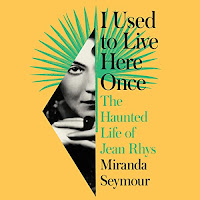"The change in Rhys at this point was absolute and devastating. Her loving hosts had become the enemy. Everything they did was wrong. Nicknaming her 'Johnny Rotten' - after the punk prince of bad behaviour - was George's way of trying to dispel a darkness in which no glimmer of light appeared. All their good times had been blotted out. Rhys ranted to everybody who dared to come near her that she was a helpless victim, deserted for weeks on end by a woman who - the unkindest cut of all - produced hideous clothes which her imprisoned guest was then compelled to buy. Even now, Diana was trying to prevent her from going home. Of course, George wrote in his ruefully honest account of the debacle, the converse was true: 'Di could hardly wait.'" (p. 358, citing Melly's "The Old Punk Upstairs", Independent on Sunday, 28 October 1990.)
Throughout her life, Rhys could be rude, aggressive and violent. Yet Seymour makes us sympathetic to Rhys and to those who suffered her "crack-ups".
Of course, that Rhys spent much of her last years feeling trapped in an upstairs room is ironic given her best-known work, Wide Sargasso Sea (1966), which (along with Jane Eyre, to which it is a prequel) was one of my A-level English set texts. What will especially linger, I think, is the decades in which Rhys's novel was in gestation, and the role of actress Selma Vaz Dias (1911-77) in reviving Rhys's literary career then seeking to control it. The novel was published when Rhys was in her 70s, the work of a lifetime given the many parallels to her own life which Seymour neatly draws out. No drafts survive, and yet Seymour teases out the development, the competing influences, the story of the book.
There's something, too, in Rhys' various names. She was born Ella Gwendolyn Rees Williams, but took on a number of aliases, as a novelist, a wife and, at the end, a patient - George Melly noted that her hospital bed was labelled "Joan". All these different characters, all these different lives, all inside one person.









No comments:
Post a Comment